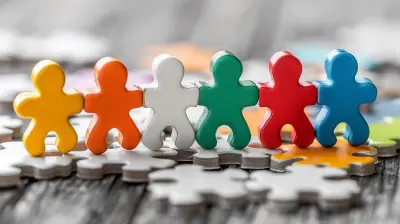Communicating with Clarity in Multilingual Environments
20 February 2025
In today’s globalized world, communication is key. But what happens when you're trying to communicate with someone who speaks a different language? Or in environments where multiple languages are spoken? That’s where things can get tricky. Multilingual environments are becoming increasingly common, whether it's in the workplace, the classroom, or even in our everyday interactions. While diversity is a beautiful thing, it can come with its own set of challenges—especially when it comes to clear communication.
But fear not! With a little bit of know-how, you can improve your communication skills and navigate these multilingual spaces like a pro. So, let’s dive into the fascinating world of communicating with clarity in multilingual environments.

Why Clarity Matters in Multilingual Communication
First off, why is clarity so important when communicating in multilingual settings? Well, language barriers can easily lead to misunderstandings, and misunderstandings can lead to bigger problems—whether it's a misinterpreted business deal, a confused student, or a breakdown in teamwork.Think of poor communication like static on a radio. The message is there, but it’s all jumbled up. In a multilingual environment, that static can be amplified. Words and phrases that make perfect sense in one language can be completely misunderstood in another. And let’s not forget about cultural differences that can add another layer to the complexity.
The Consequences of Miscommunication
Imagine this: You’re in a meeting with a team from different countries. You say, “Let’s table this for later.” In American English, that means “Let’s postpone this discussion.” But if your British colleague is in the room, they might think you mean, “Let’s discuss this right now.” Boom! Miscommunication at its finest.Miscommunication in multilingual environments can lead to:
- Lost productivity: Time is wasted clarifying or correcting misunderstandings.
- Damaged relationships: Misunderstandings can cause frustration or even offend someone unintentionally.
- Costly mistakes: Missteps in communication can lead to financial or operational errors.
In short, clear communication is essential if you want to avoid these pitfalls and foster a harmonious, productive environment.

Key Strategies for Communicating with Clarity in Multilingual Environments
So, how can you ensure that your message is understood clearly, no matter what language your audience speaks? Here are some practical strategies.1. Speak Slowly and Clearly
This may sound like a no-brainer, but you’d be surprised how often people forget to slow down when speaking to non-native speakers. When you're used to communicating in your own language, it's easy to express yourself at a rapid pace. However, when dealing with a multilingual audience, speaking too quickly can make it harder for others to follow along.Just imagine you’re listening to a podcast on double speed. You can catch bits and pieces, but you’re bound to miss some key points. The same thing happens when you speak too fast in a multilingual setting.
2. Avoid Jargon and Idioms
Every language has its own set of idioms and industry-specific jargon. While they may add color to your speech, they can also create confusion. Idioms like "barking up the wrong tree" or "hitting the nail on the head" may not translate well, and specialized jargon might be completely foreign to non-native speakers.Instead, stick to simple, straightforward language. Think of it like explaining a concept to a child or someone who’s completely unfamiliar with the topic.
3. Use Visual Aids
A picture is worth a thousand words, right? Visual aids such as charts, diagrams, and images can help bridge the gap when words fail. They provide context and can clarify complex ideas, making your message easier to grasp, especially for those who may struggle with language.For example, in the medical field, doctors often use illustrations to explain procedures to patients who may not speak the same language. Similarly, in business presentations, graphs and charts can help convey data more effectively than words alone.
4. Encourage Questions and Feedback
In multilingual environments, don’t assume that silence means everyone understands. People might be too shy or embarrassed to admit they didn’t catch something. Encourage questions and create an open environment where feedback is welcomed.You can even ask open-ended questions like, “Does anyone have any questions?” or “How does that sound?” This not only invites feedback but also gives you a chance to clarify any points that might have been misunderstood.
5. Repeat and Rephrase
Repeating key points is crucial when communicating with non-native speakers. But don’t just repeat verbatim—rephrase what you said in different words. This gives your listener another opportunity to understand your message.For example, if you say, “We need to meet the deadline by Friday,” you might follow up with, “In other words, we have to finish everything by the end of the week.”
6. Be Mindful of Non-Verbal Communication
Communication is not just about words—it’s also about body language, facial expressions, and tone of voice. In fact, studies suggest that non-verbal cues can account for more than 60% of human communication.However, non-verbal communication can vary significantly between cultures. A gesture that’s friendly in one culture might be offensive in another. For example, making direct eye contact is seen as a sign of confidence in Western cultures, but it might be considered rude or confrontational in some Asian cultures.
Being mindful of these differences can help you avoid unintentional miscommunications.
7. Learn Basic Phrases in Other Languages
You don’t need to be fluent in multiple languages to communicate effectively in a multilingual environment, but learning a few basic phrases can go a long way. Simple greetings, expressions of gratitude, or even just saying "thank you" in someone else's native language can help build rapport and show respect.Plus, it shows that you’re making an effort, which will be appreciated by your audience.

The Role of Technology in Multilingual Communication
We live in an age where technology can help bridge language barriers. From real-time translation apps to multilingual collaboration tools, there are numerous tech solutions designed to facilitate communication in multilingual environments.1. Translation Apps
Mobile apps like Google Translate or Microsoft Translator can be incredibly helpful for real-time translation. While they may not be perfect, they can give you the gist of a conversation or help you find the right word when you're stuck.However, don't rely solely on these tools. They can sometimes produce awkward or incorrect translations, so it’s always a good idea to double-check important messages.
2. Multilingual Collaboration Platforms
Platforms like Slack or Microsoft Teams now offer built-in translation features, making it easier for teams from different linguistic backgrounds to collaborate seamlessly. These tools can help ensure that everyone is on the same page, regardless of their native language.3. Automated Subtitles and Captions
If you're hosting a virtual meeting or webinar, consider using automated subtitles or captions. Many platforms now offer this feature, making it easier for non-native speakers to follow along.This is especially useful when dealing with complex topics or fast-paced discussions where it might be difficult for non-native speakers to keep up.

The Cultural Dimension of Multilingual Communication
Language and culture are deeply intertwined. When communicating in multilingual environments, it’s important to be aware of cultural differences that may affect how your message is received.1. High-Context vs. Low-Context Cultures
Some cultures rely heavily on context to convey meaning (high-context cultures), while others are more direct and explicit (low-context cultures). For example, in Japan (a high-context culture), much of the communication is implied and not directly stated. In contrast, in the U.S. (a low-context culture), people tend to be more straightforward.Understanding whether you’re dealing with a high-context or low-context culture can help you adjust your communication style accordingly.
2. Politeness and Formality
Levels of politeness and formality can vary dramatically between cultures. What might be considered a casual, friendly tone in one culture could come off as disrespectful in another.For instance, in many Asian cultures, addressing someone by their first name in a professional setting might be seen as too informal, whereas in Western cultures, it’s quite common.
3. Gestures and Body Language
As mentioned earlier, non-verbal communication can differ widely across cultures. Simple gestures like a thumbs-up or a handshake can have different meanings depending on where you are in the world. Being aware of these differences can help you avoid accidental miscommunications.Conclusion: The Power of Clear Communication
At the end of the day, clear communication is all about understanding and being understood. In multilingual environments, this can be a bit more challenging, but it’s not impossible. By being mindful of your words, tone, and body language—and by using tools and strategies to enhance understanding—you can break down language barriers and foster meaningful connections with people from all walks of life.Remember, communication is a two-way street. It’s not just about expressing your own ideas but also about listening and adapting to others. In a world that’s becoming increasingly global and interconnected, mastering the art of clear communication in multilingual environments is more important than ever.
So the next time you find yourself in a multilingual setting, remember these tips, and you’ll be well on your way to communicating with clarity and confidence.
all images in this post were generated using AI tools
Category:
Communication SkillsAuthor:

Zoe McKay
Discussion
rate this article
17 comments
Kalani McNeil
This article effectively highlights the challenges and strategies of clear communication in multilingual settings, offering practical insights for educators and learners alike.
April 1, 2025 at 11:46 AM

Zoe McKay
Thank you for your feedback! I'm glad the article resonated with you and provided valuable insights for navigating multilingual communication.
Carina Jimenez
Clear communication bridges cultures; let your words be the connection that unites us all!
March 28, 2025 at 11:46 AM

Zoe McKay
Absolutely! Clear communication is essential for fostering understanding and unity across diverse cultures. Thank you for your insight!
Taryn Rogers
Navigating the linguistic labyrinth can feel like a dance-off with grammar! 🕺💃 Embrace the quirks of each language like confetti in a parade—colorful and chaotic. Remember, clarity is the universal language that even a cat meme can translate! Let’s strut our stuff in multilingual harmony!
March 26, 2025 at 1:23 PM

Zoe McKay
Absolutely! Embracing the quirks of language enhances our communication and fosters understanding—let's celebrate our diverse linguistic dance together!
Darby Bass
What a fantastic article! 💬✨ Communicating clearly in multilingual settings is essential, and your tips are super helpful. Embracing diverse languages enriches our connections and fosters understanding. Let’s celebrate our differences and learn together! Keep up the great work in promoting effective communication! 🌍🎉
March 20, 2025 at 7:27 PM

Zoe McKay
Thank you so much for your kind words! I'm glad you found the tips helpful. Celebrating our diverse languages is indeed key to fostering understanding. Let's keep promoting clear communication together! 🌍✨
Meagan McNulty
This article offers valuable insights on enhancing communication across diverse linguistic backgrounds. Thank you!
March 18, 2025 at 8:31 PM

Zoe McKay
Thank you for your kind words! I'm glad you found the insights helpful.
Azurael Carrillo
This article provides valuable insights on enhancing communication in multilingual settings. The emphasis on clarity is crucial for fostering understanding and collaboration. Thank you for sharing these practical strategies to navigate language diversity effectively in educational environments.
March 18, 2025 at 12:19 PM

Zoe McKay
Thank you for your thoughtful feedback! I'm glad you found the strategies useful for enhancing communication in multilingual settings.
Mallory Thompson
In a world bursting with languages, clarity isn’t just a bonus; it’s a necessity. Embrace the challenge—don’t shy away from bold communication strategies. Simplify your message, break down barriers, and prioritize understanding. Elevate your multilingual interactions; effective communication is the key to inclusivity and collaboration in today’s diverse landscape.
March 18, 2025 at 4:02 AM

Zoe McKay
Absolutely! Clarity is essential in multilingual communication. By simplifying messages and fostering understanding, we can enhance inclusivity and collaboration across diverse contexts. Thank you for your insightful comment!
Hudson Anderson
This article sparks my curiosity! How do cultural nuances impact clarity in multilingual communication? I'm eager to learn strategies for effectively bridging language gaps and fostering understanding in diverse educational settings. Great topic!
March 17, 2025 at 1:07 PM

Zoe McKay
Thank you for your interest! Cultural nuances can influence interpretations and meanings in multilingual communication. To bridge language gaps, consider strategies like using visual aids, encouraging open dialogue, and being mindful of cultural context. I'm glad this topic resonates with you!
Abigail Vance
In a world bursting with languages, clarity isn't optional—it's essential. Embrace the challenge of multilingual communication with confidence. Cut through the noise by prioritizing simplicity and understanding. If we don’t invest in clear dialogue, we risk alienating voices that matter. Let’s commit to connecting, not complicating.
March 15, 2025 at 9:41 PM

Zoe McKay
Thank you for highlighting the importance of clarity in multilingual communication. Emphasizing simplicity truly fosters connection and inclusivity. Let's continue to prioritize understanding!
Laila McMaster
This article brilliantly outlines key strategies for effective communication in multilingual settings. It emphasizes the importance of clarity, active listening, and cultural awareness, enabling educators to foster inclusivity and understanding in diverse classrooms. Essential reading for modern educators!
March 11, 2025 at 5:25 AM

Zoe McKay
Thank you for your kind words! I'm glad you found the article helpful in promoting effective communication in diverse classrooms.
Bennett Gomez
This article highlights the essential strategies for effective communication in multilingual settings. By emphasizing clarity, cultural sensitivity, and active listening, it provides valuable insights that can enhance understanding and collaboration among diverse audiences. A practical guide for educators and communicators alike!
March 10, 2025 at 2:02 PM

Zoe McKay
Thank you for your thoughtful feedback! I'm glad you found the insights on clarity and cultural sensitivity valuable for effective communication in multilingual settings.
Lulu Whitaker
Love this article! 🌍✨ Clear communication is key, especially in multilingual settings. Embracing different languages not only enriches our conversations but also builds bridges between cultures. Remember, a smile and a little patience go a long way. Let’s keep sharing ideas and learning from each other—one word at a time!
March 9, 2025 at 11:49 AM

Zoe McKay
Thank you for your thoughtful comment! I completely agree—clear communication and patience are vital in multilingual settings. Let’s continue to learn and connect! 🌍✨
Miles McCune
Like juggling flaming torches while riding a unicycle, communicating in multilingual settings can be wild! Embrace the chaos, sprinkle in some humor, and watch as clarity dances through the linguistic labyrinth!" 🌍🔥🎪
March 6, 2025 at 9:47 PM

Zoe McKay
Absolutely! Embracing humor and spontaneity can transform the challenge of multilingual communication into a dynamic and engaging experience. Let's find clarity in the chaos! 🌟
Velma Newton
Great insights for effective multilingual communication!
February 27, 2025 at 1:56 PM

Zoe McKay
Thank you! I'm glad you found the insights valuable.
Sablethorn Gonzalez
Great insights! I'm intrigued by the strategies for fostering clear communication across languages.
February 26, 2025 at 3:55 AM

Zoe McKay
Thank you! I'm glad you found the insights helpful. Clear communication is essential, especially in diverse settings.
Fenris McConnell
Navigating a sea of languages? Let’s turn babble into brilliance! 🌍✨ Remember, clarity isn't just a skill; it’s a superpower. Grab your cape and get ready to communicate like a multilingual superhero! 🦸♂️💬
February 24, 2025 at 1:15 PM

Zoe McKay
Absolutely! Embracing clarity transforms communication and empowers us all. Let's harness that superpower together! 🌟💬
Gunner McClendon
Effective communication in multilingual environments requires not only language proficiency but also cultural empathy. By prioritizing clarity and active listening, educators can bridge language barriers, fostering an inclusive atmosphere. Encouraging collaboration and utilizing visual aids further enhances understanding, creating a richer learning experience for all students involved.
February 23, 2025 at 11:22 AM

Zoe McKay
Thank you for your insightful comment! I completely agree that cultural empathy and active listening are vital in multilingual settings. Your points on collaboration and visual aids are excellent strategies for enhancing understanding and inclusivity in the classroom.
MORE POSTS

The Role of Arts Education in Enhancing Creativity in Gifted Students

How Peer Tutoring Complements Teacher-Led Instruction

Unlocking the Power of Descriptive Writing

Empowering Teachers to Take on Leadership Roles in Schools

Creating Inclusive Classrooms: Strategies for Teacher Success

How to Communicate Effectively in High-Pressure Situations

How to Enhance Online Learning with Collaborative Tools

Servant Leadership in Education: Putting People First

How to Use Digital Storytelling in Virtual Classrooms

Supporting Project-Based Learning at Home

How to Train Effective Peer Tutors